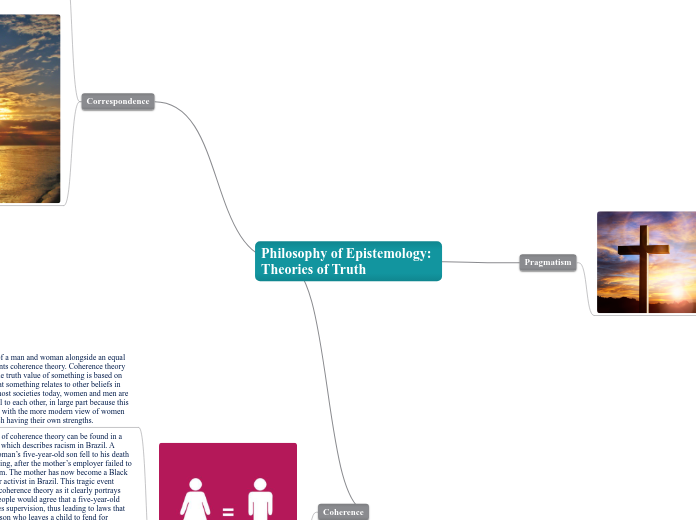Philosophy of Epistemology: Theories of Truth
Pragmatism

Another example of pragmatic theory can be found in a news article from the CNN News website. This article speculates on how Megan Markle and Prince Harry will have lots of scandalous things to say about the palace during their interview with Oprah this Sunday. The article describes how Prince Harry saw the British press as “toxic” (Picheta, 2021) which is why he fled the palace. Believing this statement of Harry’s to be true benefits anyone reading this article who longs for a clear answer as to why he cut ties to the royal family.
An example of pragmatic theory can be noted in a article, which details the mental health benefits of having a religion. Given that pragmatic theory sheds light on how certain beliefs are held to be “true” based on how beneficial they are to us, this article describes how having faith in a religion is beneficial for our mental health.
The cross represents how religious beliefs are something people cling to as “true”, because it provides comfort and benefit. Pragmatic theory describes how we choose to believe certain things as “true”, because believing it is true benefits us in some way. Many people have a religion because it provides them with a sense of community and belonging. For example, Christians may not be able to one hundred percent prove that Jesus really did exist and promised eternal life, yet believing that Jesus is real and that doing good can guarantee one eternal life benefits a person.
Noticing pragmatic theory in these articles helped me recognize how I often believe something to be true because it benefits me in some way.
Correspondence
Subtopic

Another example of correspondence theory is found in a CBC News article, which discusses the impact breathing in cold air during outdoor exercise has on the lungs. Professor from the University of Alberta, Michael Kennedy states in the article “Over time, if you repeat that irritation or that provocation, the lung just becomes less capable of healing itself” (Glowacki, 2021). The validity of this statement is backed up by the real-life examples included in the article and scientific literature.
An example of correspondence theory can be noted in a news article, which describes how the coronavirus will likely become endemic. This statement is considered “true” by many scientists, because it relates to the way many other viruses have become less deadly as the number of people infected grows. The validity of the statement; “the coronavirus will become endemic” is supported by how it relates to the world (as outlined in correspondence theory).
I chose this photo of a sunrise to represent correspondence theory. Given that correspondence theory centres around the idea that reality is made up of basic truths, it makes sense to include a picture of a sun rising. A given truth is that the sun has risen and continues to rise each new day. This truth represents the reality that the sun really does rise up in the sky every morning.
Paying attention to how correspondence theory is present in these two articles helped me see how what is held as true is seen as "true" based on how well it reflects reality.
Coherence

The image of a man and woman alongside an equal sign represents coherence theory. Coherence theory states that the truth value of something is based on how well that something relates to other beliefs in society. In most societies today, women and men are held as equal to each other, in large part because this belief aligns with the more modern view of women and men each having their own strengths.
An example of coherence theory can be found in a news article which describes racism in Brazil. A Brazilian woman’s five-year-old son fell to his death from a building, after the mother’s employer failed to supervise him. The mother has now become a Black Lives Matter activist in Brazil. This tragic event connects to coherence theory as it clearly portrays how most people would agree that a five-year-old child requires supervision, thus leading to laws that punish a person who leaves a child to fend for themselves.
Another example of coherence theory can be found in an article describing International Women’s Day and the fight for gender equality in Atlantic Canada. Today’s societies are taking note of the importance of upholding gender equality and this belief has grown exponentially over the years. Women are being encouraged to enter into the STEM field, traditionally dominated by men. Believing that both genders are equal aligns with the greater belief in society that all of us are equal and have valuable skills to contribute.
Taking note of coherence theory in these two articles helped me better reflect on the ways a common belief shared by most members of society helps develop the legal system and ethics.
